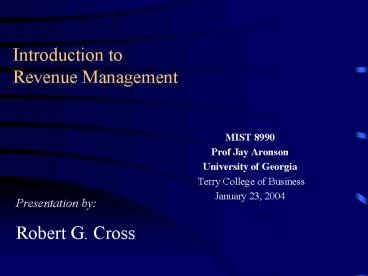Introduction to Revenue Management PowerPoint PPT Presentation
1 / 36
Title: Introduction to Revenue Management
1
Introduction to Revenue Management
- MIST 8990
- Prof Jay Aronson
- University of Georgia
- Terry College of Business
- January 23, 2004
Presentation by Robert G. Cross
2
Objectives ofRevenue Management
- Revenue and Profit Optimization
- Focus on revenue generation, not cost reduction,
to increase profits - Typical financial goal is to achieve a 4 to 8
increase in top line revenues on an annual,
recurring basis - Flow-thru of incremental revenues are
significant in high fixed asset businesses - Central Repository of Corporate Market Knowledge
- Centerpiece for decision management database
- Anticipates future business conditions for both
strategic and tactical responses
3
Pricing Leverage
A 5 Improvement In
Increases Profits By
Source McKinsey Co.
4
The Creation of Wealth in a Post-Capitalist
Society
5
Technology as a Knowledge EnablerRevenue
Management as a Wealth Creator
6
The Origin of ModernRevenue Management
- The Convergence of
- Airline Deregulation
- and
- Improvements in Information Technology
7
Revenue Management
Economists Definition- A means of allocative
efficiency that maximizes economic wealth through
dynamically forecasting the self-seeking
activities of each individual consumer
8
Price Differentiation ThroughRevenue Management
Selling the
- Right Product to the
- Right Customer at the
- Right Time for the
- Right Price
9
No-Tech Revenue Management at Carols Barber
Shop
10
Revenue Management-Process Flow
?
MarketSegmentation
Customer Demand Data
Forecasters
!
Constraints
Optimization
Market
Price and Availability Recommendations
11
Price Differentiation the Key to
Effective Revenue Management
12
Price Differentiation -
- Understanding What the Customer IsWilling To Pay
- Seller Charges Value Perceived By That Customer
Segment
13
Practical Problems withPrice Differentiation
- Customers Reluctant to Say How Much They Really
Value a Product
- Perception of Value Changes Based on Time, Place,
and Circumstance
- Competition/ Substitutable Alternatives Affect
Price Perception
Revenue Management uses probable customer
behavior gleaned from data and statistical
analysis to optimize price
14
Micro-Market Segmentation-- A Practical
Application of Micro-Economic Theory
15
Single Price Optimization
100
REVENUE 2,500
50
PRICE
1
1
50
100
DEMAND
16
Price Differentiation - Multiple Prices
100
80
REVENUE 4,000
60
PRICE
40
20
1
1
20
40
60
80
100
DEMAND
17
Price Differentiation-Differentiated Product
Creation
100
80
60
PRICE
40
20
1
1
20
40
60
80
100
DEMAND
18
Real World Differential Pricing American
Airlines Case Study
19
Real World Differential Pricing American
Airlines Case Study
20
Break
21
Customer Values Differ for Different Product
Attributes
- Physical Attributes
- Time Attributes
- Environmental Attributes
- Experiential Attributes
- Personal Perception Attributes
22
Buying Behavior Matrix
23
Customer Product/Price Trade-offs
Decision
24
How Revenue Management Optimizes ProfitFor Any
Business
Predict Customer Demand
Optimize Price
Recalibrate Dynamically
Segment the Market
Segmentation based on purchasing behavior, not
just current or past classifications
Forecasts of demand and capacity at product/price
level
Continually monitor performance and update
market response
Mathematically determine capacity availability
and price that maximizes expected profit
25
Step 1 Segment the Market
- Segment the account base according to
price-response characteristics for each - product
- The objective is to define observable market
segments, each with different market response - Clustering techniques are
- used in defining micro-
- markets
26
Step 2 Determine Price-Response Influences
27
Step 2 Measure Market Response By Market
Segment
100
90
80
70
Price Sensitivity
60
50
Probability of Winning Bid ()
40
Brand Preference
30
20
10
0
0.60
0.70
0.80
0.90
1.00
1.10
1.20
1.30
1.40
Our Price versus Competitor Price (Ratio)
28
Step 3 Optimize Price / Maximize Profit
Cost Information
Contribution (100)
X
Net Price
Likelihood of Winning ()
Market Information and Strategic Goals
Net Price
Optimal Price
2005
Optimal Price
(c) 2004 Robert G. Cross
29
Step 4 Dynamically Recalibrate
Customer Demand
Price and Availability
Results In Long-Term Profit Maximization
30
Case Studies
- B2C High Dollar Retail Transactions
- B2B - Competitive Bid Situations
- ecommerce B2C - High Volume, Transparent
Environment
31
Case StudyFord Motor Company
- The Problem How to Optimize Customer Incentives
over millions of vehicles - The Solution
Predict Customer Behavior
Optimize Response
Dynamically Recalibrate
Segment the Market
- Geography
- Vehicle Type
- Incentive Device
- Competition
- Response to Promotion By Segment
- Probability of Winning
- Competitive Response
- Vary Discount
- Vary Device
- Vary Time
- Measure Response
- Update Models
Result Expected savings of 800 million per year
32
Case StudyUnited Parcel Service
- The Problem How to Optimally Price a Hundred
Thousand Annual Contracts - The Solution
Predict Customer Behavior
Optimize Response
Dynamically Recalibrate
Segment the Market
- Calculate Optimal Point Maximizing Probability of
Win at Greatest Margin
- Region
- Customer Type
- Competition
- Strategic Goals
- Probability of Winning
- Probable Margin
- Measure Success
- Update Models
Result Increased revenue and profit in excess of
120 million per year
33
Case StudyTickets.com
- The Problem How to Maximize Event Attendance at
the - Highest Possible Price
- The Solution
Predict Customer Behavior
Optimize Response
Dynamically Recalibrate
Segment the Market
- Optimize Price
- Optimize Capacity
- Venue
- Event
- TOD/Dow
- Experience
- Response to Price
- Probability of Winning
- Measure Success
- Update Models
Result Increased revenue in excess of 8 to 12
per event
34
Wealth Creation Through Pricing and Revenue
Management
35
Questions?
36
Introduction to Pricing and Revenue Management
- MIST 8990
- Prof Jay Aronson
- University of Georgia
- Terry College of Business
- January 23, 2004
Presentation by Robert G. Cross

